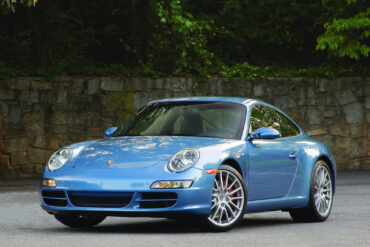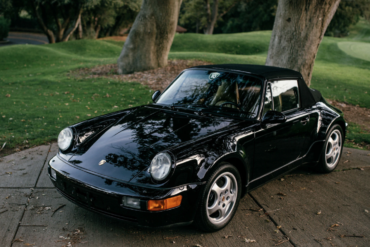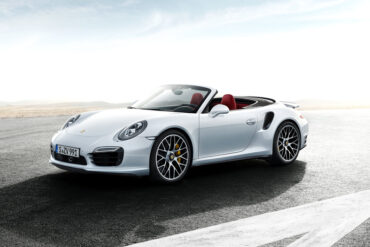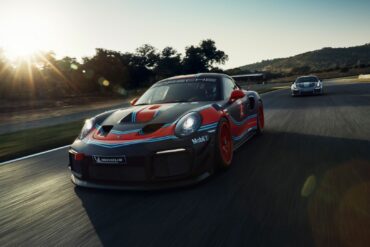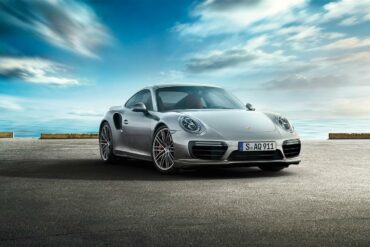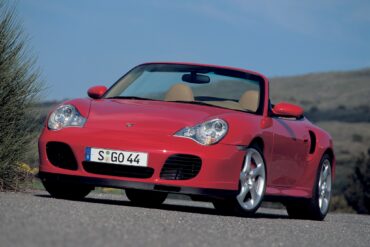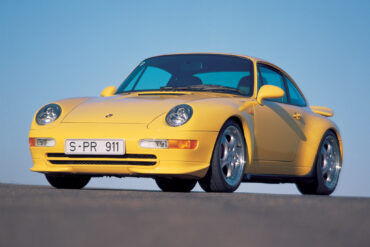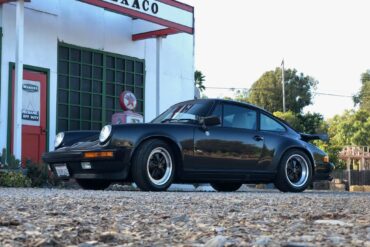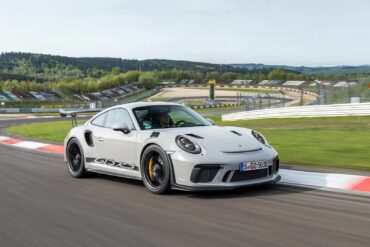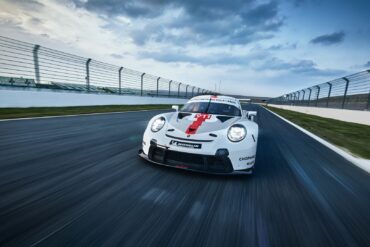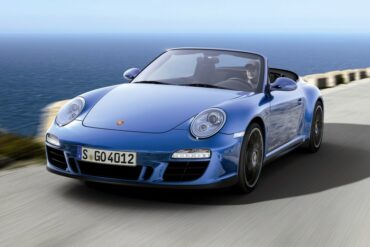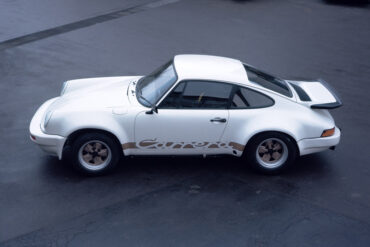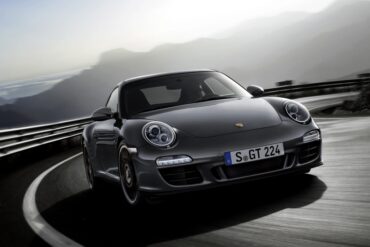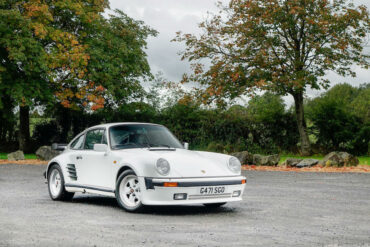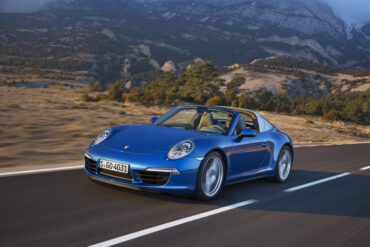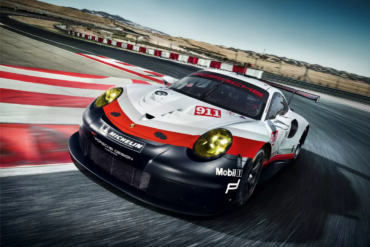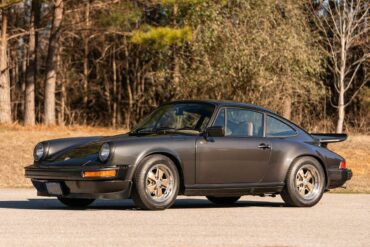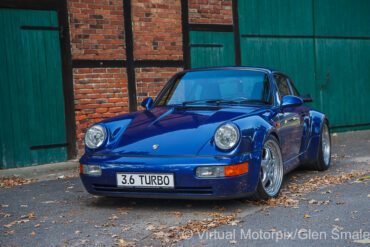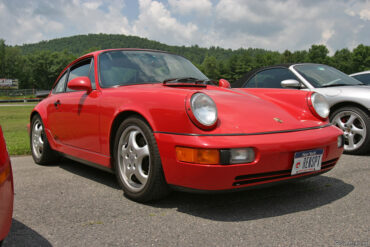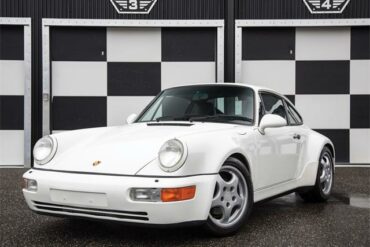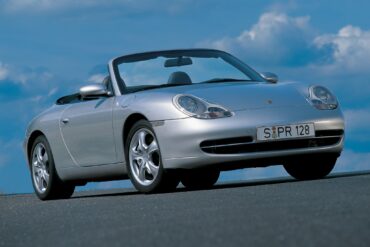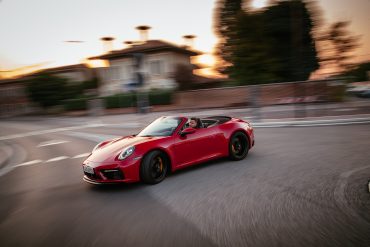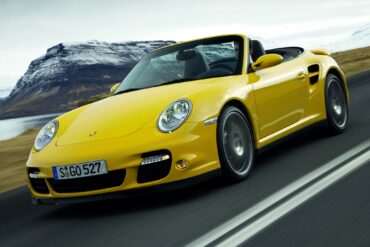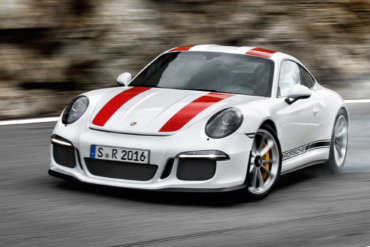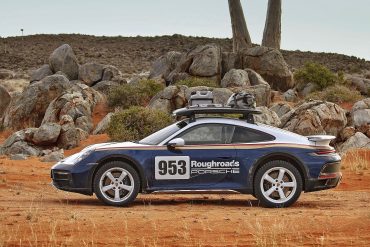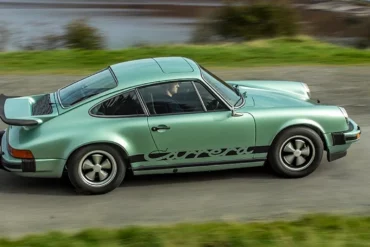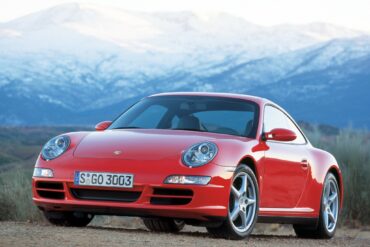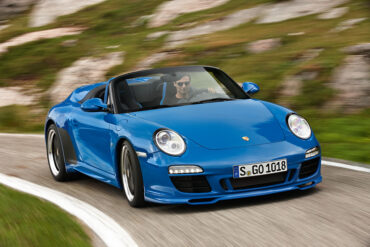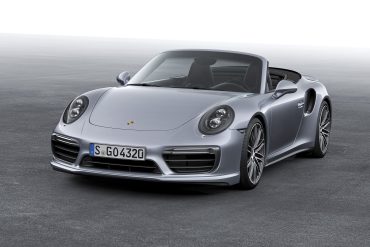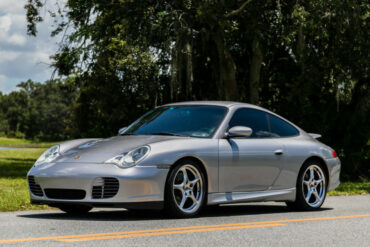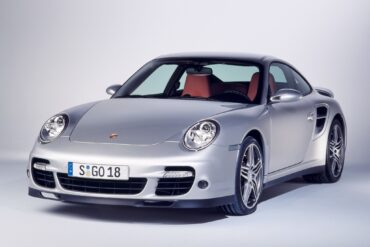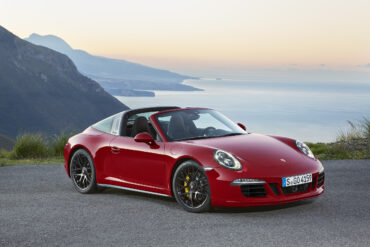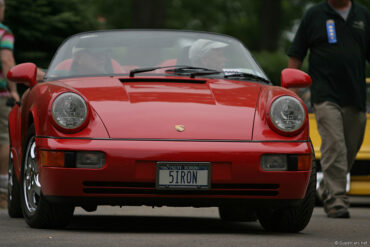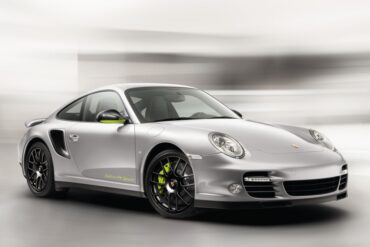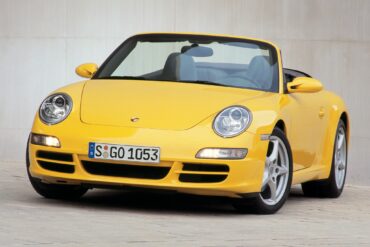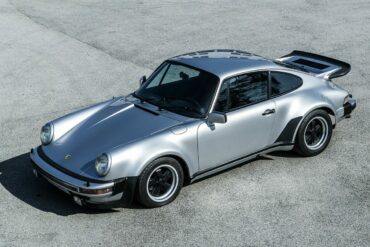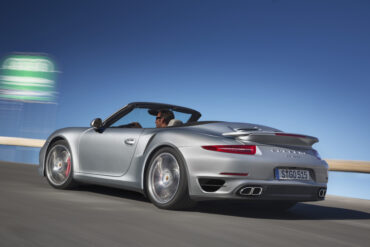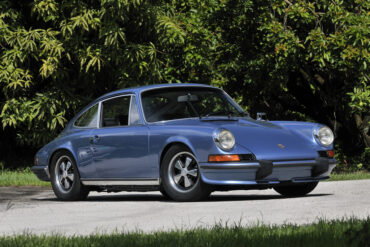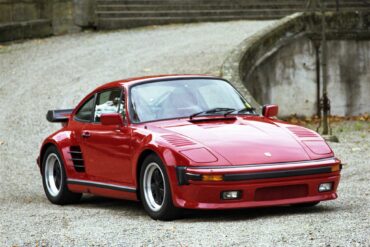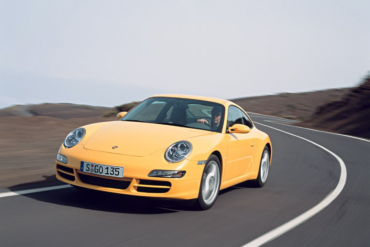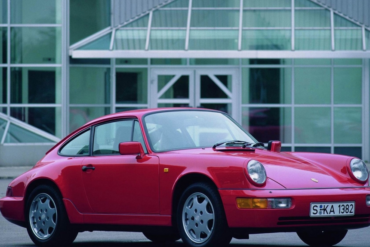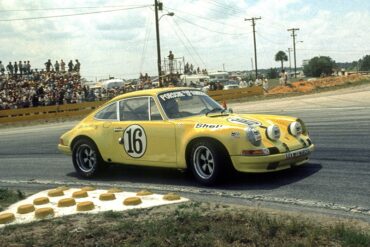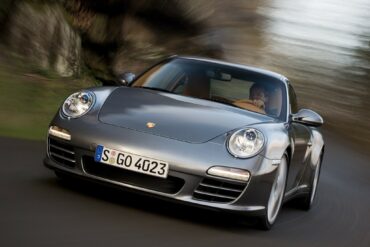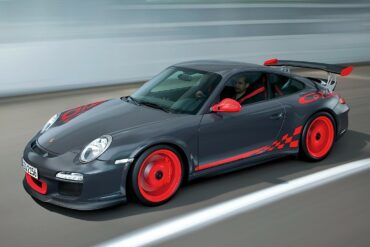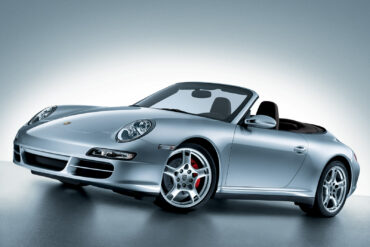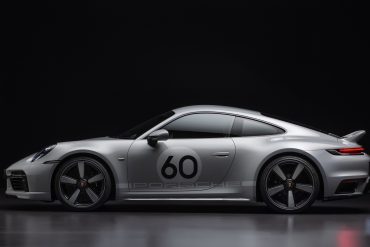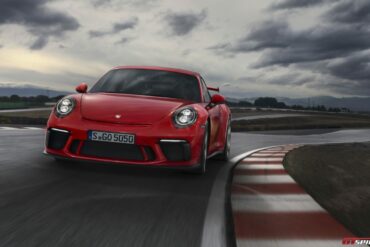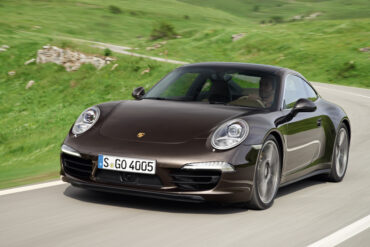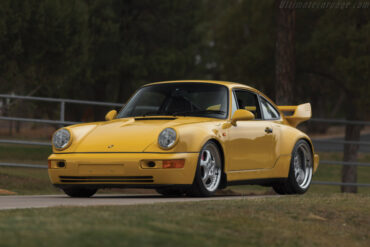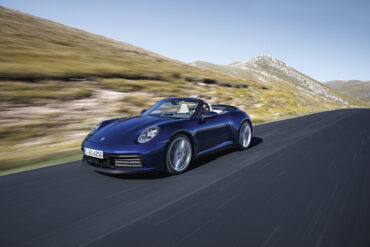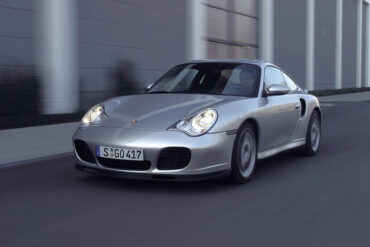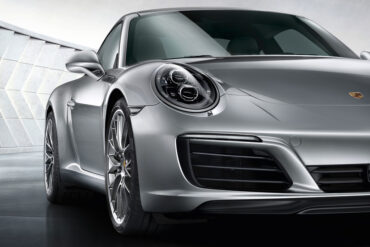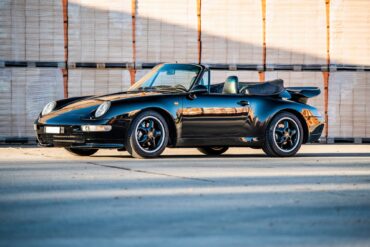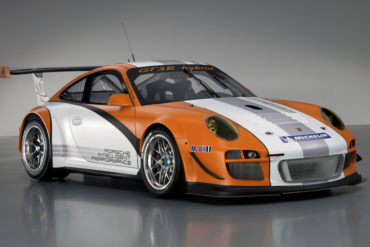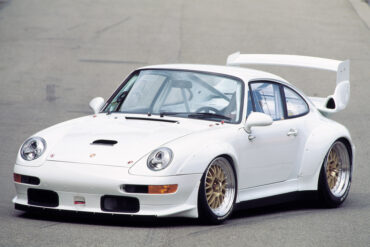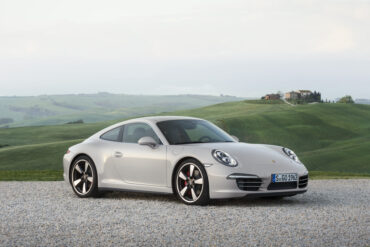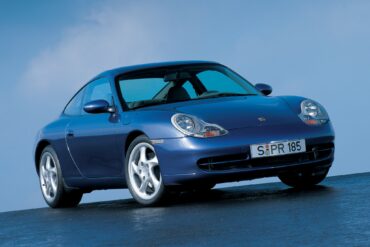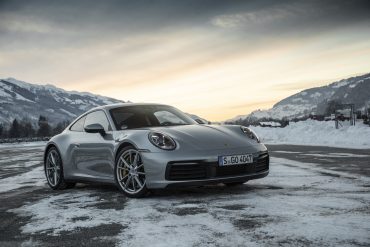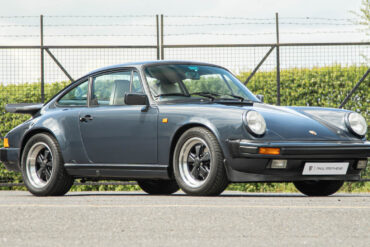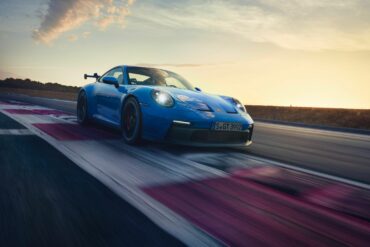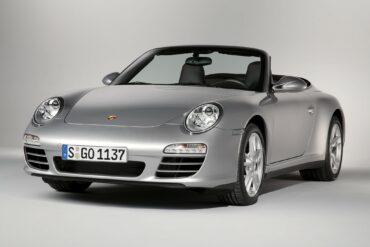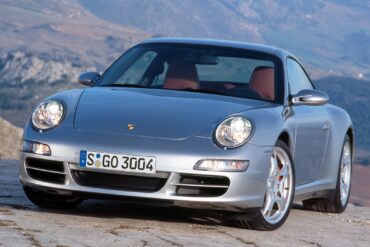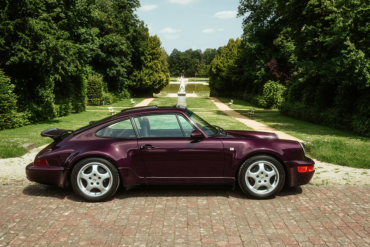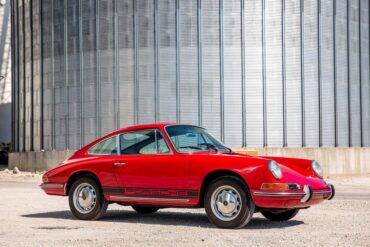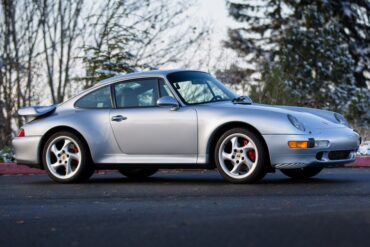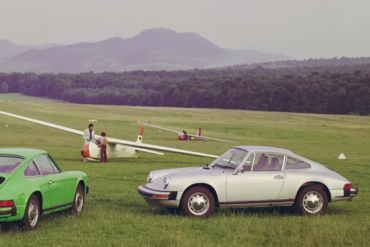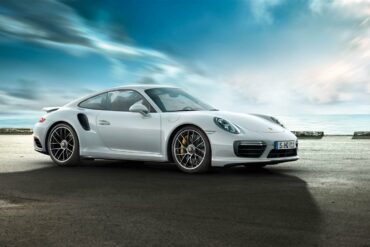In recognition of the 50th Anniversary of the Porsche Club of America (PCA), Porsche has created an exclusive 911 Carrera' S Coupe model featuring a distinctive exterior color, unique interior styling and commemorative touches, and a more powerful and higher performing engine. Limited to an exclusive production run of just 50 cars initially made available to eligible PCA members, the 911 Club Coupe was unveiled this past weekend at PCA's 50th Annual Porsche Parade in Hershey, Pa.
The American Roadster is essentially a turbo-bodied Carrera Cabriolet with Turbo suspension and brakes. Like the 356 America Roadster it was named after, the Type 964 America Roadster was a limited-edition, driver-focused convertible destined for the American market. Production for the America Roadster was limited at only 250 examples, and the model was only produced in 1992 and 1993. Its engine was a standard unit making 250 horsepower, but the special edition had the wide fender flares, suspension, brakes, and 17-inch Porsche Cup wheels of the 911 Turbo.
Everything you need to know about the 991.1 Turbo S Cab comes from Car and Driver test results. "Launch control puts the computer in charge and sends the 3741-pound Turbo S Cab to the far side of 60 mph in just 2.8 seconds. A quarter-mile that nearly breaks into the 10s—11.1 seconds at 124 mph—attests to how serious this car gets when provoked. We saw 1.0 g on the skidpad and a stopping distance of 151 feet, both strong numbers abetted by the hilariously staggered Pirelli P Zeros (245/35 in front, 305/30 in back)". This is in a comfortable, all-wheel drive, grand touring convertible.
This car was officially called as the 911 GT2 RS Clubsport, but the name is rather misleading. The car was not built for the GT2 racing class which is long extinct and club sport has stood for Porsche club track days while this non-streel-legal car is a real racing car. Finally, the car was based on the 991 GT2 RS, which already had the Clubsport version. So, in order to understand what is what, we call it "991 GT2 RS Clubsport racing version". The 991 GT2 RS engine with 515 kW was powerful enough, so it was not tuned.
At the heart of the 991.2 911 Turbo is a twin-turbocharged flat-six with 540 horsepower and 523 pound-feet of torque. That’s a meaningful 20 more horses than the 991.1 Turbo. Improvements that come from increases in boost and fuel-injection pressures. Rounding the skidpad, the Turbo posts 1.02 g’s relatively easily. The wide P Zeros in back and the standard four-wheel steering conspire to hide the fact that 62 percent of the Turbo’s 3656 pounds sits over the rear wheels. With sport-plus selected, the 991.2 Turbo hits a 1.0-second run to 30 mph and a 2.6-second zero-to-60 time.
Introducing this new top-of-the-range model, Porsche is once again placing a 911 Turbo Cabriolet right at the top of the family after a break of 14 years: From 1987 - 1989 the Porsche 930, as the first Turbo was code-named within the Company, set the first milestone in the history of these outstanding open-air sports cars. With cylinders still featuring two valves each at the time, the 3.3-litre power unit driving the first Turbo Cabriolet offered maximum output quite unique at the time of 300 bhp or 221 kW. Acceleration from 0 to 100 km/h was in 5.2 seconds and the car had a top speed of 260 km/h or 161 mph.
The 993 Carrera RS is a lightweight, stiffer version of the naturally-aspirated 993 Carrera meant for ultimate street performance. At its heart was the 3.8-liter normally aspirated Type M64/20 engine producing 300 bhp at 6,500 rpm along with 262 foot-pounds of torque at 5,400 rpm. Looking to save as much weight as possible, every non-essential item from the car was removed. The Carrera RS tipped the scales at a 1,280 kg. About 1,000 Carrera RS were built, making it one of the rarest and most collectable 993-generation 911's produced. In addition to the Base Trim it was also available as the race-ready, street legal, RS Clubsport (option M003).
For 1989, Porsche produced the 25th Anniversary Special Edition model to mark the 25th year of 911 production. The 1989 Porsche brochure lists production of 500 U.S. market cars, of which 300 were coupés (240 in silver metallic paint and 60 in satin black metallic), and 200 cabriolet models (160 in silver and 40 in black). All had "silk grey" leather with black accent piping and silk grey velour carpeting. Includes small bronze "25th Anniversary Special Edition" badges.
Matt Prior from Autocar nails the 991.2 GT3 RS: “While I don’t think the 3 communicates any better than a 2, the messages it does transmit are superior: you can feel that it’s lighter, more willing to turn, easier and more satisfying to ease onto the throttle and keep it pinned. It’s why this car is only a few seconds slower than a 2RS around the Nürburgring Nordschleife despite being almost 200bhp down.” He goes on... “And in the form of the GT3 RS it goes into creating - little by little, detail by detail - what might just be the best driver’s car currently on sale.”
This was the fourth version of the 991 RSR - the first two came with the rear engine, then the first mid-engine version was launched (all 4.0-litre) and finally the mid-engined RSR 4.2 with the largest 911 engine ever made. The increase in the engine capacity is a question mark as on production models the capacities are decreased and turbochargers are used. The 991 RSR 4.2 didn't have anything in common with the production cars anymore. No change in terms of power-to-weight ratio.
The Cabriolet version of the new Porsche 911 Carrera 4 GTS is just as potent as its coupe sibling. It combines a 408 hp 3.8-litre flat six engine with intelligent all-wheel drive that delivers a further exhilarating dimension to the dynamics of the iconic rear-engined sports car. The 911 was first offered with four-wheel drive in 1989 and the drivetrain has been a popular option ever since. Now, the 911 Carrera 4 GTS broadens customer choice in 2011, building on the success of the two-wheel drive Carrera GTS that went on sale in December last year. Carrera 4 GTS power unit is the 3.8-litre flat six with power kit.
Following the famous 1973 F-model 911 Carrera RS 2.7, Porsche built its successor based on the G-model and it was called the 911 Carrera RS 3.0. With its 172 kW engine, it was the most powerful series production street-legal Porsche made so far. With its new 3.0-liter engine, featuring mechanical fuel injection, it was capable of 230 hp. While 1,580 Carrera RS 2.7s were built for 1973, only 56 Carrera RS 3.0s were built for 1974.
The new Porsche 911 Carrera 4 GTS combines a 408 hp 3.8-litre flat six engine with intelligent all-wheel drive that delivers a further exhilarating dimension to the dynamics of the iconic rear-engined sports car. The 911 was first offered with four-wheel drive in 1989 and the drivetrain has been a popular option ever since. Now, the 911 Carrera 4 GTS broadens customer choice in 2011, building on the success of the two-wheel drive Carrera GTS that went on sale in December last year. The 911 Carrera 4 GTS power unit has its origins in the 3.8-litre, six-cylinder from the Carrera S, with the power kit added.
Only 50 units made. The 911 Turbo Limited Edition comes equipped with the 330 bhp power unit normally only available in the 911 Turbo with Sport Equipment. In addition, the fitment of a limited slip differential as standard ensures the the increased engine performance can be used to it’s fullest extent. This Limited Edition also adopts the rear wheel air intakes of the Sport Equipment version. Essentially an SE without a slantnose front.
For this 991 generation Targa, Porsche went back to the original Targa concept, albeit with an even sexier design and some very cool technical tricks to boot. Porsche wanted to resurrect its classic design, but the company feared that owners would not want to get out of the car, lift off the roof panel, and stow it in the trunk. The other issue was, in the words of 911 product line director Dr. Erhard Mossle, "that the manual solution was a little bit old-fashioned." The 911 Targa 4 gets the same 350 horsepower, 3.4-liter six-cylinder motor as its hardtop siblings.
Two decades after the different 911 GT1 cars the mid-engined 911 is back! In order to install a proper diffuser under the rear end of the 991, the engine had to make room for it and the engine/transmission unit was rotated 180 degrees. The extended rear diffuser, a top-suspended rear wing and the new side mirrors help to increase downforce with reduced drag. The FIA rules meant no turbo was needed due to power limits, so the normally aspirated 4-litre flat-6 was taken from the 991 GT3 R.
In 1980, a true limited edition model 911SC was produced for the American market. The 'Weissach' edition was a standard SC with special paint. It was built in 1980 to honor the Porsche Motorsport team working in Weissach Germany. 468 units were made and half were painted Metallic Black, the other half in Platinum Metallic. The interiors were wrapped in Doric Grey leather with burgundy piping. Additional body and mechanical specs included whale tail spoiler, Bilstein dampers and Fuchs wheels.
Engine based on modified 3.6 litre 964 unit. Speedline wheels with big red brake calipers. Lessons learned in the Carrera Cup series proved the reliability of the new 3.6-litre engine. An additional three millimetres on the bore and two millimetres on the stroke, resulted in an increase in capacity of 300 cc. Combined with the turbo optimised cylinders, pistons and crank train, and an increase in the compression ratio from 7.0 to 7.5:1, this helped to boost power to 360 bhp. Torque was increased significantly to 520 Nm at 4200 rpm, up from 450 Nm at 4500 rpm in the earlier car.
The original 1973 Carrera RS was available in Europe but not in the USA. Porsche decided to build the 1993 Carrera RS both to European spec and a limited number in compliance with US regulations. These US spec cars were assigned the name “RS America”. The intent was to create a basic lightweight, no frills 911 with minimal luxury options. The standard US Carrera 2 brakes, engine and gearbox were used. The RS weighed 2,945 pounds so it was almost 80 pounds lighter than a standard Carrera 2.
Model year 1994. Carrera 4 Wide-Body for the U.S. Technically there is really no difference between the Carrera 4 Wide-Body and his RoW counterpart. At the front there are the for America usual black impact absorbers beside the fog lights, the frontfenders lack the side indicators, the rear bumper is equipped with the center piece with a small plate section and in the back window of a large third brake light is integrated. Significant differences, it is generally provided in the factory standard equipment.
The 996 Cabriolet was introduced in March 1998 at the Geneva Motor Show. The 996 Cabriolet was long ready (remember, it was tested already in 1995), but for marketing and production-related reasons it was launched in 1998 as a 1999 model. While the evolution with the 911 coupe was questionable from 993 to 996, the real evolution came with the cabriolet. In USA - the biggest market - 911 Cabriolets outsold the Coupés. The all-wheel-drive system provides between 5-40% of torque to the front wheels depending on the situation.
Porsche is the most successful marque in the 24 Hours of Le Mans and British drivers have played an important role in delivering these historical achievements, and in celebration of this success a special limited edition model – the 911 Carrera 4 GTS British Legends Edition was created. Designed by the drivers who took wins in the 24 Hours of Le Mans for the factory team – Richard Attwood (winner 1970), Derek Bell MBE (winner 1981, 1982, 1986, 1987) and Nick Tandy (winner 2015) – this model was developed by Porsche Cars GB and Porsche Exclusive Manufaktur.
The 2022 Porsche 911 Carrera GTS Cabriolet arrives with 473 horsepower and 420 ft lbs of torque. Porsche's ultimate Carrera cabriolet model is brilliant, and flexible. Sure, you can go faster in a 992 911 Turbo, but we guarantee it won't be as much fun or as engaging as the GTS Cabriolet. This is just a great car, an all-round sports car that combines effortless performance with open top fun. It gets a 3.0-liter twin-turbocharged flat-six engine producing 473 horsepower.
Like the 911 Turbo Coupe, the 997 Turbo Cabriolet is powered by a 3.6 liter six-cylinder boxer engine with biturbo turbocharging and Variable Turbine Geometry (VTG). The powerplant already generates 480 hp (473 bhp) and 460 ft lbs of torque at 1950 rpm. The manual transmission version can accelerate from 0 to 100 km/h in just four seconds while the Tiptronic S the time can be cut to 3.6 seconds. Top speed for the Cab is the same 193 mph as Coupe and only weighs 70 kilos.
Sticking to their strengths, Porsche has created the most sought after car in its line-up, the 2017 Porsche 911 R. We have seen numerous rumors about this car for a couple of months now and this time we finally get to see it. The new Porsche 911 R with 4-litre naturally aspirated flat-six engine with a six-speed manual gearbox is coming to us for sure. It's lighter and faster with its engines pumping out 493 bhp at 8,250 rpm and 333 lb-ft at 6,250 rpm. The result is probably the best 911 of the modern era. Porsche at its finest.
Porsche makes sports car history by launching its first publicly available rally car, the $223,450 911 Dakar. After extensive testing, Porsche has settled on a 3.0-liter twin-turbo six-cylinder boxer engine with 473 hp and 420 lb-ft of torque and an 8-speed PDK. True to rally form, an 80-mm suspension lifts the car, along with an optional roof rack and model-specific Pirelli Scorpion all-terrain tires.
In 1974 Porsche offered a high performance fuel injected Carrera specifically for the European market. These were close to 2.7 RS specification and are often referred to as the 2.7 or Euro Carrera. In many regards, this car is similar to the 1973 2.7 RS in touring trim, with its 210bhp 911/83 engine, but the 2.7 Carrera is based on the updated G-series body and interior. Later Carreras that reach American shores used had reduced power and throttle response compared to Euro counterparts.
The 997 Carrera 4 was the all-wheel-drive version of the standard 997 Carrera and it arrived as a 2006 model year car (along with the 4S models). The 997.1 Carrera 4 had a3.6 L Watercooled Flat 6 (M96/05) engine that was good for 321 bhp @ 6800 rpm and 273 ft lbs @ 4250 rpm. It had a sub 5 second 0 - 60 mph hour time and a top speed of 174 mph. The transmission (six-speed manual or five-speed Tiptronic) feeds a forward propshaft that mates to a viscous coupling unit with a front differential.
Paying homage to the first Porsche model that bore the name Speedster – the 356 Speedster – the production run for the new model is limited to 356 cars. The two-seater is significantly different from the other members of the 911 family. In the best tradition, the 60 millimetre lower, more raked windscreen, the flat contour of the sporty-look manual hood, and the characteristic double-bubble hardcover for the soft top define the striking profile of the new 911 Speedster. This makes the body of this rear-wheel drive with its 44 millimetre wider rear stand out even more.
The Cabriolet version of the 991.2 Turbo got the same updates as its coupe sibling. The engine in the 991.2 911 Turbo Cabriolet is a twin-turbocharged flat-six with 540 horsepower and 523 pound-feet of torque, up a decent 20 more horses versus the 991.1 Turbo Cab. Improvements that come from increases in boost and fuel-injection pressures. Rounding the skidpad, the Turbo posts 1.02 g’s relatively easily. The wide P Zeros in back and the standard four-wheel steering conspire to hide the fact that 62 percent of the Turbo’s 3656 pounds sits over the rear wheels. 0 - 60 mph is over in just 3 seconds.
To commemorate the 40th year of 911 production, Porsche built 1963 of the 40th Anniversary Porsche 911 Carrera for model year 2004. Painted only in a GT Silver Metallic finish, with a dark gray leather interior, the 40th Anniversary (or 40 Jahre in German) took the Base Model 996 Carrera and added the front fascia of the 996 Turbo, side skirts and luxury features for the cabin – including a luggage set that matched the special grey leather interior. Mechanically, the X51 Powerkit increases power to 341hp, combined with rear wheels power wheels, a standard 6-speed manual and sport suspension and limited-slip differential included.
The sixth generation of the 911 series’ top-of-the-range model was unveiled at the 2006 Geneva Motor Show. The 997 911 Turbo has 473 bhp @ 6000 rpm, 60 bhp more than its predecessor. Rated torque is now 473 bhp @ 6000 rpm. The speed range in which this power is available has also been extended. While the previous model’s maximum torque was available between 2,700 and 4,600 revolutions per minute, the corresponding figures are now 1,950 to 5,000 revs. 0 to 60 mph is over in a blistering 3.6 seconds and top speed is 193 mph. The ultimate GT.
The 911 Targa 4 GTS isn't the fastest or best performing 911. It is heavier, softer and not as fast as every other GTS model. But we still love it. The Targa 4 GTS has amazing performance coupled with the sexiest body in the business. In GTS trim the Targa body looks even better. This is the car you get when you can only choose one 911 and you need it for fun weekends, daily driving and taking the wife out to a fancy restaurant. With 450 hp and 405 lb-ft from 2150 to 5000 rpm, it also has more than enough street performance than you could ever need. Buy one.
The 964 based Speedster was the 1994 Speedster which was based on the 964 Carrera 2 platform. There are far fewer 1994 911 Speedsters in the world than the 1989 model, with production reportedly totaled only around 936 units, less than half as many as the 1989 example. Whereas the 1989 Speedster was primarily an aesthetic package, the 964 version sought a happy medium between the regular Carrera 2 and the hardcore Carrera RS. It had the same engine as the base Carrera and didn’t have the same suspension bits as the RS.
Based on the 530-bhp 911 Turbo S, the special-edition Porsche has carbon-fiber trim inside and out, plus upgraded leather, badging and the exterior colors of the 918, including the use of Acid Green on the brake calipers, illuminated sill plates, interior stitching and instrument cluster needles. Also limited to 918 units, the 911 Turbo S Edition 918 Spyder will be available in Coupe ($160,700) and Cabriolet ($172,100) forms, making this one very expensive dealer option.
Just a few months after the introduction of the 2004 911 (997 series), the convertible version was released. The release of the 997 911 Carrera Cabriolet marked the first time since 1977 that Porsche has given the convertible 911s the same engines as their Coupe siblings. The base 997 Carrera Cabriolet gets the 3.6-liter flat six-cylinder engine with 321 bhp and 273 ft lbs of torque. The convertible version for both Carrera and Carrera S was developed at the same time with the coupe.
The 911 Turbo was put into production in 1975. While the original purpose of the 911 Turbo was to gain homologation for the 1976 racing season, it quickly became popular among car enthusiasts. Ernst Fuhrmann adapted the turbo-technology originally developed for the 917/30 CAN-AM car and applied it to the 3.0 litre flat-six used in the Carrera RS 3.0, thus creating what Porsche internally dubbed as the 930. Total power output from the engine was 260 bhp and 254 ft lbs of torque.
2013 Porsche 911 Turbo Cabriolet Stuttgart. The dynamic range of the new 911 Turbo models1) multiplied by the driving pleasure...
The final early 911S befitted from Porsche's 2.4-liter engine the the long-wheel-base body. As such it is one of the final classic 911s before the 2.7 came out in 1973. Visually, the 2.4 range received a new chin on the front valence that was standard on the 911S and optional for the rest of the range. The S model had slight larger 6Jx15 Fuchs alloy wheels over the other models. The final early 911S benefitted from Porsche's 2.4-liter engine the the long-wheel-base body
Slantnosed and based on that of the 935 racecars, with pop-up headlamps. The front spoiler was made deeper in order to accommodate the extra oil cooler, while intakes in the rear wings fed air to the brakes. The larger turbocharger and four-outlet exhaust gave 30bhp of extra power. Porsche began their “special order program” offering a Flachbau option (Slantnose) for the 930 in very limited production. All of this at a cost of nearly 2 times the standard 930S.
The base Carrera has essentially the same 3.6 L flat-6 engine that its predecessor, the Type 996 Carrera used, now good for 321 bhp @ 6800 rpm and with torque of 273 ft lbs @ 4250 rpm. The sprint from 0 to 60 mph is over in just 4.80 seconds and top speed is 177 mph. The quarter mile is over in a respectable 13.1 seconds. The 911 Carrera is now faster, more stable, more precise and forgiving, an altogether superior-make that more efficient-sports car than the 996.
Porsche added the rear wheel drive Carrera 2 variant to the range in 1990. It was developed alongside the 964 Carrera 4, Porsche waited a year to release the Carrera 2 as a 1990 model year car. Like the Carrera 4, the Carrera 2 was available as a coupé, Targa or Cabriolet. Overall, the Carrera 2 packed almost the same technical specifications as the Carrera 4 model. The engine was the same 3.6 liter unit which produced 250 horsepower and a maximum speed of 162 mph. Looked like C4 but was 200 lb lighter and more fun to drive.
Porsche developed the S/T, of which 33 were built in 1970 and 1971, taking full advantage of new FIA rules allowing a two-inch wider track. Accordingly, wheel arches were widened to accommodate seven-inch front and nine-inch rear wheels. Weight reduction was even more radical, including thinner-gauge steel for the roof and floorpans. Heating ducts, seat slide supports, the glove-box lid, ashtray, sun visors and rear torsion-bar covers were deleted.
Most importantly, the refreshed Carrera 4 and 4S lose the old multi-plate, viscous all-wheel-drive system in favor of the electronically controlled system from the 911 Turbo. The old system could send between 5 and 40 percent of engine torque to the front wheels once it had detected wheelspin. The new electronic system can anticipate traction losses and shift up to 100 percent of engine torque fore or aft. Porsche says the new AWD system reacts faster to traction changes, and doesn’t make the Carrera 4 significantly heavier.
Based on the already primal 997.2 GT3, the RS gets another 15 hp from the 3.8-liter flat-six for a total of 450, or more than 118 hp per liter. A racing machine tamed for street use, the GT3 RS is hardly just about horsepower. It gets a wider track, it weighs less, and it produces more downforce than the GT3. The only available transmission is a six-speed manual gearbox (with the ratios even shorter than the GT3). A racing machine tamed for street use, the GT3 RS also gets a wider track, it weighs less, and it produces more downforce than the GT3.
While the 997 Carrera 4S coupe sold a healthy 15,056 units between 2006 and 2008, the equally exciting Carrera 4S Cabriolet sold 12,587 units, making it a pretty popular 997 model. The reason is pretty simple. It had a gorgeous wide-body stance, all-wheel drive traction and that potent 3.8 L Flat 6 that was good for 350 bhp and 295 ft lbs of torque. The first convertible 911 that was as good a performer as it coupe siblings with the added benefit of open top driving in the summer with the comfort of being a great daily driver all year round.
A total of 1,250 examples of the limited-edition model by Porsche Exclusive Manufaktur. While the original was a Carrera S, this time around, the power and handling come from a much feistier car, the Type 922 Turbo S. Returning is that amazing grey paint, that swooping ducktail spoiler, and the double-bubble roof. All-new is a mildly detuned Turbo S engine producing 543 HP and 442 lb-ft of turbocharged torque, mated to what can only be called a gift from the gods, a 7-speed manual gearbox.
A 911 for the road and track – the new Porsche 911 GT3 Stuttgart. The Porsche 911 GT3 delivers motorsport-like performance,...
The new all-wheel drive 911 is being launched on the market in four versions – as the 911 Carrera 4 and 911 Carrera 4S and each as Coupé and Cabriolet. The Coupé and Cabriolet of the 911 Carrera 4 S each have a 3.8-litre rear-mounted boxer engine that produces 400 hp (294 kW); this enables acceleration to 100 km/h in 4.1 seconds (Cabriolet: 4.3 seconds) and a top speed of 299 km/h (Cabriolet: 296 km/h) with a suitable equipment configuration. Fuel consumption values with PDK are 9.1 l/100 km (CO2 215 g/km) for the Coupé and 9.2 l/100 km (CO2 217 g/km) for the Cabriolet.
The 964 Carrera RS 3.8 was produced as a base for homologation for the venerable 3.8 RSR. It was unveiled in 1993 and produced in a very small series by Porsche’s Racing Department in Weissach-Flacht, and was an extreme evolution of the 964 Carrera RS that was released two years prior. It featured the wide-body look of the Type 964 Turbo, a massive rear spoiler, and three-piece “Speedline for Porsche” wheels with 235/40 and 285/35 tires, making it distinctively more aggressive in appearance than the fairly restrained styling of the Carrera RS of 1992 and capable of providing significantly more mechanical grip.
Top down summertime driving in the current 911 Carrera 4S Cabriolet is about as good as it gets. It checks all of the right boxes, as while it has matured into almost a GT-type car; it still boasts more performance than ever. Like the rest of Carrera S models, the Carrera 4S Cabriolet is powered by the same 3.0-liter twin-turbo flat-six that makes 443 horsepower and 390 ft lbs of torque. It comes standard with the same eight-speed twin-clutch automatic transmission.
The 2005 Porsche 996 Turbo S was available as both a coupe and cabriolet – it was basically a standard Turbo model with the X50 Powerkit and carbon-ceramic brakes fitted, alongside a few luxury features for the interior. Approximately 1558 Turbo S models (split between coupe and cabrio) were sold in 2005. Also included are small aluminum appointments to the interior and Turbo S badging. A great all-rounder with the extra power to surprise most. The Turbo S with manual transmission (coupé) sprints from zero to 200 km/h in 13.6 seconds. This is another 0.8 seconds faster than the 911 Turbo. Quite rare, with only a total of 600 units made.
Porsche purists might moan that the flat-six engine in the rear is no longer naturally aspirated, but with more power and torque, improved efficiency and some advanced interior tech giving this 911 an even bigger breadth of ability than before, this facelifted 991-generation model carries on where the old car left off. Sure, it’s lost a touch of that high rev zing from the old car, but if you add the sports exhaust, the bark from the engine inside and out is still intoxicating. And so is the speed. The 991.2 Carrera S is absolutely amazing on both road and track and still the best sports car around.
The Porsche 911 Turbo Cabriolet (993 generation) is an incredibly rare car – only 14 were built in 1995, in the early days of 993 production. Rather than the contemporary twin-turbo powerplant in the 993 Turbo Coupe, the 993 Turbo Cab was fitted with the single turbo of the 964 Turbo 3.6. Although the Turbo Coupé was introduced earlier, the actual production started after the Turbo Cabriolets were sold. Turbo Cabriolets were 1995 models by VIN and Turbo Coupés were immediately produced as 1996 models although the 1996 model year had not yet started.
The Porsche 997 GT3 R Hybrid 2.0 is an update to the 997 GT3 R Hybrid. Compared to its predecessor, which debuted in 2010, the 2011 second-generation hybrid is 20 percent lighter and more efficient without any concession to lap times. While sharing the same paint scheme, the new vehicle is easily identified by its lack of intakes in front of each rear wheel - changes to engine cooling allowed the slats to be dropped and aerodynamic efficiency improved. It gets a traditional race-bred flat six engine. The GT3 R Hybrid has a completely independent second driveline in the front of the chassis, a clever and complex hybrid electric set up that rockets it from standstill to 60 mph in just 2.5 seconds.
The Porsche 911 GT2 Evo represented the top specification ever produced for any air-cooled Porsche. Designed to compete in FIA GT1, it incorporated a twin turbocharged 3.6L flat-6 engine rated at a full 600 HP and 491 lb-ft of torque. As compared to the standard 993 GT2, Porsche widened the rear fender extensions to cover wider modular wheels and added a new front spoiler with inlets for oil and brake cooling. A second deck appeared on the already outlandish rear spoiler, which could be mounted higher in the air stream for added downforce. Approximately 11 samples were produced.
The 2014 50th Anniversary Edition 911 was built by Porsche to commemorate the 911’s birthday, 50 years after its production launch in 1964. In homage to 1963, the year the 911 debuted at the 1963 Frankfurt Motor Show, production was limited to 1,963 units. The 50th Anniversary uses the wider body from a Carrera 4S (but remains only rear-wheel-drive) and is lower than a standard Carrera by 10mm. The 20 inch-alloys are a modern take on the original Fuchs wheels, and the seats are finished in “Pepita” cloth. Includes Porsche Active Suspension Management (PASM), sports exhaust and powerkit tickled 430 hp flat six.
Since 1989, the rear-wheel-drive Carrera has always been accompanied by an all-wheel-drive Carrera 4, and the 996 was no different. Overlapping with the last year Carrera 993'S, the 996 Carrera 4 represented two major changes for the venerable 911 lineage: a water-cooled flat-6 engine replaced the air-cooled engine used in the previous 911 model, and the body shell received its first major re-design. Engine was 3.4 L and power was 296 hp featuring a change to an "integrated dry sump" design and variable valve timing.
The perfect daily driving sports car with an all-weather, remarkably high-performance envelope. Like the rest of Carrera S models, the Carrera 4S is powered by the same 3.0-liter twin-turbo flat-six that makes 443 horsepower and 390 lb-ft of torque. It also comes standard with the same eight-speed twin-clutch automatic transmission with the same gear ratios, except the 4S with an added clutch and differential up front.
The replacement for the SC series came in 1984 as the 911 3.2 Carrera, reviving the Carrera name for the first time since 1977. This was the last iteration in the original 911 series, with all subsequent models featuring new body styling and new brake, electronic, and suspension technologies. Almost the same galvanised body as the SC. Engine was claimed to be 80 per cent new, and the first production 911 to feature an ECU to control the ignition and fuel systems.
The 992-era 911 GT3 confirms that Porsche is prepared to go to astonishing lengths to keep the hardcore faithful happy. The engine is a naturally aspirated 4.0-litre that revs to 9,000 rm and has little in common with the unit found elsewhere in the 992 range and a lot to do with the one in the GT3 Cup car. Power is up a modest 10bhp to 503 bhp, torque to 347 ft lbs. That’s more than enough. It’ll accelerate to 62mph in 3.4 seconds. It is the best sports car on the planet.
The 2009 Porsche 911 Carrera 4 Cabriolet shares the same internal 997 model designation as its Coupe siblings. It also shares the same essential all-wheel-drive architecture, interior appointments, suspensions and drivetrains. It is an open-top sports cars that deliver the same exhilarating acceleration and dynamic response as the coupes, regardless of weather or road conditions. The Carrera 4 Cabriolet boast a unique body over their all-wheel-drive powertrains with a wide-body design.
Along with its sibling Carrera 4, the 2005 Carrera 4S offered an all-wheel-drive system for the Porsche 911, but unlike the 4, the 4S gets the Carrera S' more powerful engine and it turns out that makes a big difference. The Carrera 4S was the more powerful and more dynamic version of the 997 Carrera 4 and an overall great sports car, especially for those in colder climates who need the safety of all-wheel traction. All rounder that fits nicely in the 911 lineup as perhaps the most practical.
In March 1993, Porsche presented the Porsche 911 anniversary model “30 years 911” at the Geneva Motor Show. Since then, the special model is also called “Jubi” for short. Under the Porsche internal code M096, there is essentially a Carrera 4 with the wide turbo body but without wings. The 964 anniversary edition could be ordered with exclusive interior design and numerous possibilities of customization. According to Porsche, the special model was limited to 911 vehicles and manufactured in the model years 1993 and 1994.
Put most simply, a 912 is essentially a 911-style body mated with a 356-derived 4-cylinder engine. The 356 was Porsche’s first mass-marketed sports car. The Porsche 911 is the most successful sports car of all time. the new 912 came equipped with 90HP motor was a slightly detuned version of the 95HP motor that had powered its predecessor, the 356SC. However, despite this reduction of power, and despite the 912 being a heavier car, it was actually faster than the 356SC thanks to more streamlined aerodynamics and a more advanced suspension system.
The 993 Turbo was available between late 1995 to 1998. Powered by a twin-turbocharged 3.6 liter flat six, it was rated at 402-horsepower. It’s distinguished easily from the rear, as the whale-tail spoiler is quite deep to house the intercoolers meant to cool the intake charge. This extra power might have been a handful for street drivers, so all-wheel drive from the 993 Carrera 4 added traction at all four corners. Approximately 6,000 coupes were made. Although powered by a different engine, a limited production 993 Turbo Cabriolet was available in the early days of the 993 generation. A more powerful 993 Turbo S was also introduced in 1997.
Also produced for the 1976 "model year", for the U.S. market, was the 912E, a 4-cylinder version of the 911 like the 912 that had last been produced in 1969. It used the I-series chassis and the 2.0 Volkswagen engine from the Porsche 914. In all, 2092 units were produced. In 1976, the Porsche 924 took this car's place for the 1977 "model year" and beyond. The power was supplied by a 4-cylinder high-performance fuel injection motor also used in the Volkswagen 411.
With the Turbo S, the PDCC Porsche Dynamic Chassis Control hydraulic roll bars came as standard. The PCCB Porsche Ceramic Composite Brakes had been standard on the Turbo S already since the 996 generation. New options included the radar-based lane change assist and a lift system for the front axle (increased ground clearance by 1.6″/40 mm). The PCM now had a multi-touch screen like in the facelifted 991 Carrera. Routes and places could be visualized with 360-degree images and satellite images. Engine gets more horsepower too, now with 572 bhp and 553 ft lbs of torque.
No More Content


